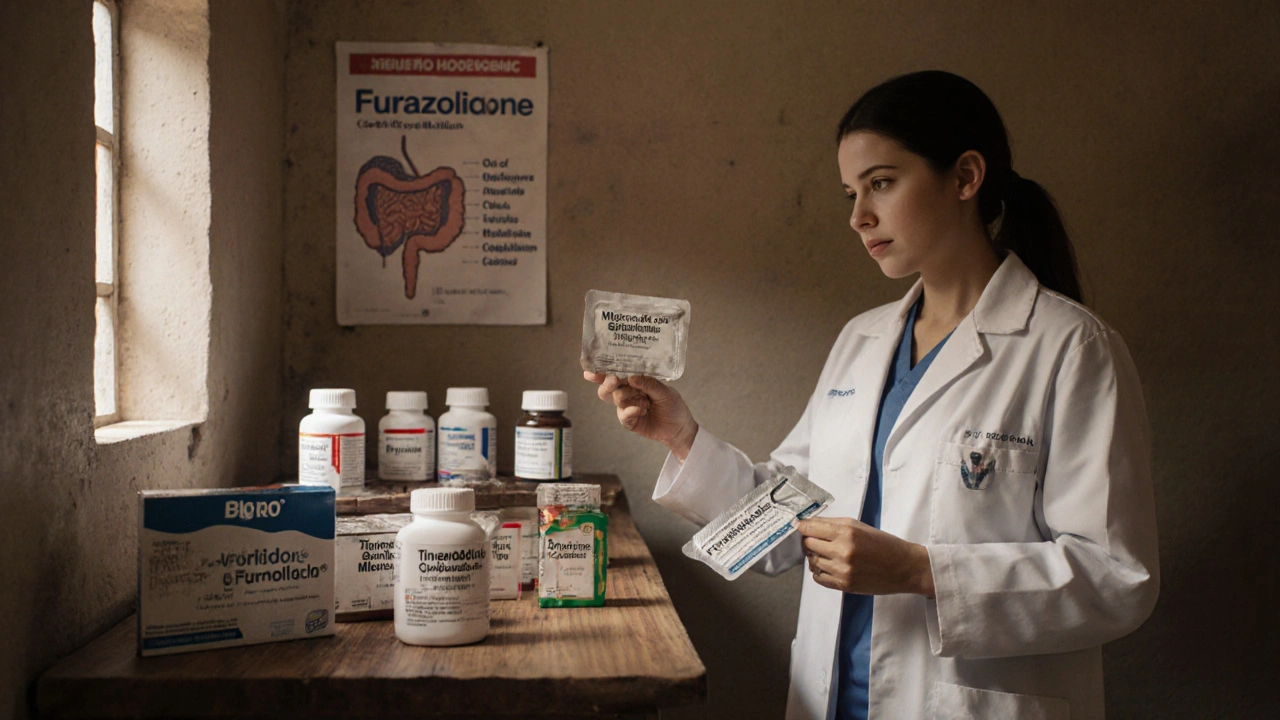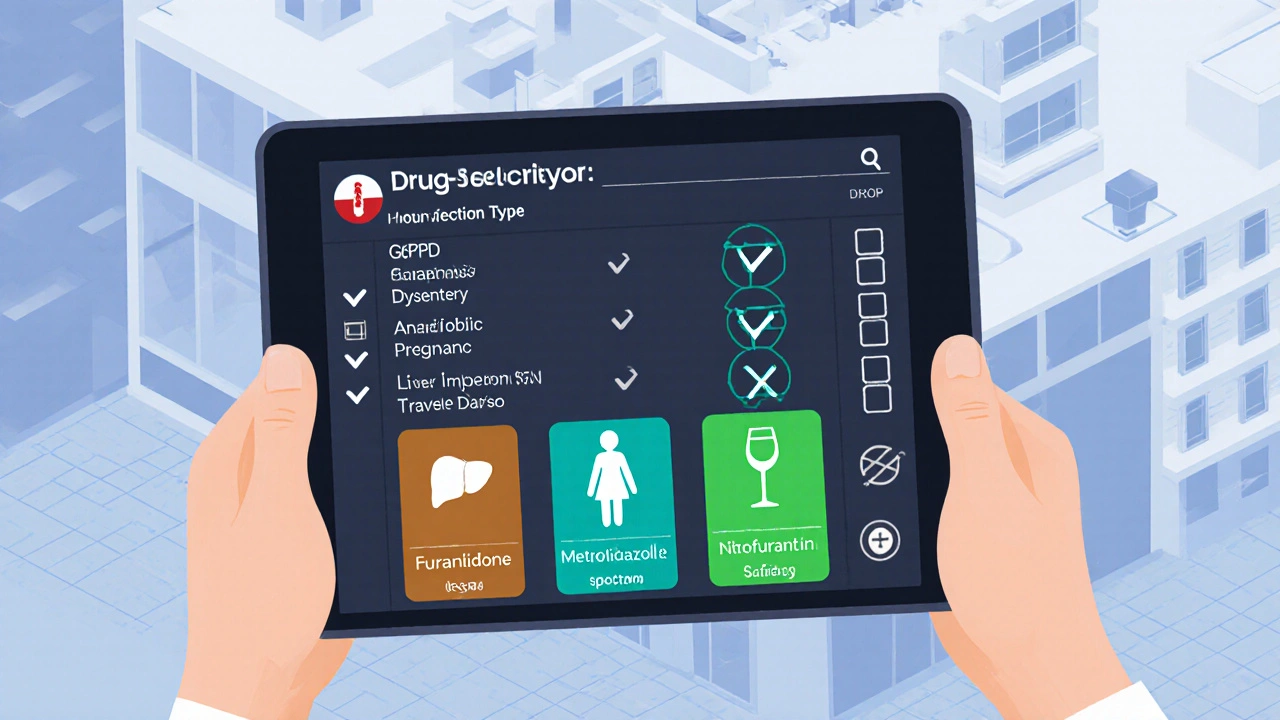 Oct, 4 2025
Oct, 4 2025
Furazolidone vs Alternatives: Drug Selector Tool
Recommended Treatment Option
Furazolidone: Effective for dysentery, giardiasis, and anaerobic infections. Considered cheaper but has higher risk of liver toxicity and drug interactions.
Metronidazole: First-line for anaerobic infections and protozoal diseases. May cause metallic taste and peripheral neuropathy with prolonged use.
Tinidazole: Similar to metronidazole but with a longer half-life. Allows single-dose treatment for trichomoniasis and giardiasis.
Nitrofurantoin: Preferred for uncomplicated UTIs due to excellent tolerability and low resistance rates.
Ciprofloxacin: Broad spectrum but associated with resistance and tendon toxicity. Not recommended for children or pregnant women.
Amoxicillin: Good for respiratory and skin infections. May cause rash and allergic reactions.
When doctors need a nitro‑furantoin‑type drug for gastrointestinal infections, they often reach for Furazolidone - a synthetic nitrofuran antibiotic first introduced in the 1950s. It’s cheap, has a broad spectrum against anaerobes and some protozoa, and still shows up on formularies in low‑resource settings. But the drug also carries a reputation for nausea, liver concerns, and a ban in several high‑income countries. That’s why clinicians and patients keep asking: what are the real Furazolidone alternatives and how do they stack up?
Quick Summary
- Furazolidone is effective for dysentery, giardiasis, and certain anaerobic infections but has notable toxicity and drug‑interaction risks.
- Metronidazole and Tinidazole are the go‑to nitro‑imidazole choices for most protozoal infections, offering better safety and shorter courses.
- Nitrofurantoin remains the first‑line oral agent for uncomplicated urinary‑tract infections (UTIs), with a narrower spectrum but excellent tolerability.
- Ciprofloxacin and other fluoroquinolones provide broad coverage for gram‑negative pathogens but raise concerns about resistance and tendon toxicity.
- Choosing the right agent hinges on infection type, patient comorbidities, local resistance patterns, and how the drug is metabolized.
How Furazolidone Works
Furazolidone belongs to the nitrofuran class. Inside bacterial cells it undergoes reduction by nitroreductases, forming reactive intermediates that damage DNA, proteins, and cell membranes. This mechanism makes it active against a wide range of gram‑positive and gram‑negative bacteria, as well as anaerobes and several protozoa such as Giardia lamblia and Entamoeba histolytica. Because the drug is a pro‑drug, hepatic enzymes play a big role in activation - a factor that also explains its hepatotoxic potential.
Key Comparison Criteria
To evaluate Furazolidone against other options, we look at five practical dimensions:
- Spectrum of activity - which microbes are reliably killed?
- Safety profile - common side effects, organ toxicity, and drug interactions.
- Pharmacokinetics - absorption, half‑life, and need for dose adjustments.
- Resistance risk - how quickly does the pathogen develop tolerance?
- Cost & availability - especially important in low‑resource settings.

Comparison Table
| Drug | Spectrum | Typical Indications | Common Side Effects | Resistance Concerns | Cost (US$/course) |
|---|---|---|---|---|---|
| Furazolidone | Broad - aerobic, anaerobic, protozoa | Dysentery, giardiasis, travel‑related diarrhea | Nausea, vomiting, hepatotoxicity, hemolysis (G6PD) | Low in isolated settings; higher where OTC use is rampant | ≈$5‑$8 |
| Metronidazole | Anaerobes, protozoa | Clostridioides difficile, bacterial vaginosis, giardiasis | Metallic taste, nausea, peripheral neuropathy (long‑term) | Moderate; resistance rare in protozoa | ≈$10‑$15 |
| Tinidazole | Similar to metronidazole, slightly broader | Trichomoniasis, giardiasis, amebiasis | Headache, bitter taste, mild liver enzyme rise | Low; cross‑resistance with metronidazole rare | ≈$12‑$18 |
| Nitrofurantoin | Urinary‑tract gram‑negative rods | Uncomplicated UTIs | Urinary burning, pulmonary toxicity (long use) | Low; resistance ↑ in ESBL‑producing E. coli | ≈$6‑$9 |
| Ciprofloxacin | Broad gram‑negative, some gram‑positive | Travelers' diarrhea, complicated UTIs, prostatitis | Tendon rupture, QT prolongation, CNS effects | High; global resistance rising | ≈$8‑$12 |
| Amoxicillin | Gram‑positive, some gram‑negative | Otitis media, sinusitis, pneumonia | Rash, GI upset, rare hepatotoxicity | Moderate; beta‑lactamase producing strains | ≈$5‑$10 |
When Furazolidone Might Still Be the Right Choice
Even with newer agents, Furazolidone shines in a few niche scenarios:
- Resource‑limited clinics where price and availability trump safety concerns.
- Patients with contraindications to nitro‑imidazoles - for example, those on disulfiram or with severe alcohol intolerance.
- Multi‑drug‑resistant anaerobes where first‑line agents have failed and susceptibility testing shows low MICs for Furazolidone.
In these cases, the prescriber should monitor liver enzymes, avoid concurrent alcohol, and test for G6PD deficiency to prevent hemolysis.
Alternatives Overview - What Works Best for Which Infection
Metronidazole is the workhorse for most anaerobic infections and protozoal diseases. A 5‑day course for giardiasis typically clears symptoms faster than Furazolidone and carries a lower risk of liver injury. However, it can interact with alcohol (disulfiram‑like reaction) and cause peripheral neuropathy if used for months.
Tinidazole offers a longer half‑life, allowing single‑dose regimens for trichomoniasis and a 3‑day course for giardiasis. Its side‑effect profile is milder than metronidazole, making it attractive for pregnant patients (though still classified as Category B).
For uncomplicated urinary‑tract infections, Nitrofurantoin remains superior. It concentrates in urine, sparing systemic exposure, and has a very low resistance rate in community‑acquired E. coli. The main caution is avoiding it in patients with reduced renal function (CrCl <60mL/min) or those who need long‑term therapy.
If the infection is gram‑negative but extra‑intestinal, Ciprofloxacin provides excellent tissue penetration. Yet the global rise in fluoroquinolone resistance means susceptibility testing is essential before prescribing.
Amoxicillin is rarely a direct substitute for Furazolidone because its spectrum doesn’t cover many anaerobes. Still, for mixed‑flora respiratory infections it can replace broader agents, reducing collateral damage to the gut microbiome.
Practical Tips for Clinicians
- Confirm the pathogen with stool microscopy or PCR before opting for a nitrofuran.
- Check liver function tests (ALT/AST) at baseline and after 7‑10 days of therapy.
- Screen for G6PD deficiency in patients of African, Mediterranean, or Asian descent.
- Educate patients to avoid alcohol for at least 48hours after the last dose of Furazolidone or Metronidazole.
- When cost is a barrier, verify that the local pharmacy stocks the generic form of Metronidazole - it often costs less than Furazolidone when insurance covers it.

Frequently Asked Questions
Is Furazolidone still approved for use in the United States?
No. The FDA withdrew Furazolidone due to safety concerns and a lack of recent efficacy data. It remains available in some developing countries under strict regulation.
Can I take Furazolidone and Alcohol together?
Absolutely not. Furazolidone, like Metronidazole, can cause a severe disulfiram‑like reaction - flushing, rapid heart rate, nausea, and vomiting. Avoid alcohol for at least 48hours after the final dose.
What makes Metronidazole a safer option for giardiasis?
Metronidazole has a well‑established safety record, a shorter half‑life, and fewer hepatic side effects. In most trials, a 5‑day course clears Giardia in >90% of patients, whereas Furazolidone often requires 7‑10days and carries a higher risk of liver enzyme elevation.
When should I choose Nitrofurantoin over Furazolidone?
If the infection is limited to the urinary tract and the patient has normal renal function, Nitrofurantoin is preferred. It concentrates in urine, has minimal systemic toxicity, and is cheap - making it a clear first‑line agent for uncomplicated cystitis.
Does resistance to Furazolidone develop quickly?
Resistance is relatively low in isolated settings, but in regions where the drug is sold over‑the‑counter and used indiscriminately, resistant strains of Shigella and Salmonella have been reported. Routine susceptibility testing is advised where labs are available.
Bottom line: Furazolidone still has a place in the antimicrobial toolbox, especially where cost constraints dominate. Yet for most modern clinical settings, safer and better‑studied alternatives like Metronidazole, Tinidazole, or Nitrofurantoin will provide similar efficacy with fewer headaches. Always match the drug to the infection, the patient’s health profile, and the local resistance data - that’s the smartest way to keep both microbes and patients in check.
Naomi Ho
October 4, 2025 AT 16:31Furazolidone hits a broad range of gut pathogens but its hepatic metabolism means you need to check liver enzymes before and during therapy
Christine Watson
October 13, 2025 AT 03:11Nice to see a tool that breaks down the options – it makes the decision process feel less intimidating and more manageable. It’s great when the data is laid out side‑by‑side so you can compare cost, safety, and coverage at a glance.
Macy Weaver
October 21, 2025 AT 13:51Looking at the spectrum column, Furazolidone certainly covers more bases than Nitrofurantoin, but the safety trade‑off is real. For patients with G6PD deficiency the hemolysis risk alone pushes me toward Tinidazole or Metronidazole. In settings where laboratory monitoring is limited, the cheaper price of Furazolidone can be appealing, yet you have to weigh that against the need for liver function tests. Overall, the tool does a solid job of highlighting those nuanced decisions.
James McCracken
October 30, 2025 AT 00:31One could argue that the very existence of a selector tool reflects our collective desire to quantify what has always been a qualitative art. Yet we must ask ourselves: does reducing antimicrobial choice to a series of checkboxes strip away the clinician’s responsibility to consider the patient’s narrative? The algorithmic approach assumes that each variable-G6PD status, liver function, pregnancy-can be isolated, whereas in reality they often intersect in unpredictable ways. Moreover, the notion that a cheaper drug is automatically preferable ignores the hidden costs of adverse events, which can outweigh the initial savings. A drug like Furazolidone may appear cost‑effective on paper, but the downstream monitoring required may impose a burden on both the health system and the individual. The paradox lies in the fact that we celebrate precision medicine while simultaneously relying on blunt instruments such as cost alone. In examining the table, note that resistance is listed as ‘low’ for Furazolidone, yet the data behind that claim are sparse in many low‑resource regions where the drug is still over‑the‑counter. This raises the question of whether the resistance column truly reflects contemporary surveillance or merely a historical snapshot. Additionally, the side‑effect profile-hepatic toxicity, hemolysis, disulfiram‑like reactions-serves as a reminder that pharmacodynamics are not static; they evolve as we learn more about patient populations. The decision to prescribe must also factor in the health literacy of the patient: can they understand the need to avoid alcohol while on the drug? If the answer is no, the theoretical efficacy becomes moot. Finally, the tool’s design promotes a binary mindset-‘choose this or that’-instead of encouraging a dialogue about alternative pathways, such as non‑pharmacologic supportive care where appropriate. In sum, while the selector provides a convenient overview, it should never replace the nuanced, patient‑centered conversation that is the hallmark of good practice.
Evelyn XCII
November 7, 2025 AT 11:11Sure, because nothing says "trustworthy" like a drug that makes your liver scream.
Suzanne Podany
November 15, 2025 AT 21:51When you’re counseling a patient from a community clinic, it helps to frame the choice in terms of what they can actually obtain. Explain that while Furazolidone is inexpensive, the need for regular liver checks can be a barrier if they don’t have easy access to labs. Offer the alternative of Metronidazole if they can handle the short metal‑taste, or Tinidazole for a single‑dose regimen that avoids frequent follow‑up. Emphasizing cultural sensitivity-like acknowledging dietary restrictions or traditional remedies-builds trust and improves adherence.
Nina Vera
November 24, 2025 AT 08:31Drama alert! Imagine standing in a dimly lit pharmacy, clutching a bottle of Furazolidone while the ominous soundtrack of liver enzymes rising plays in the background. Then-BAM-enter the hero: Tinidazole, swooping in with a single dose and a whisper of fewer side effects. The crowd goes wild! It’s the kind of plot twist that makes you want to grab popcorn and watch the showdown between cheap and safe unfold.
Christopher Stanford
December 2, 2025 AT 19:11Let’s cut through the hype. The data on Furazolidone’s efficacy is dated, the safety signals are real, and the market pushes it because it’s cheap. If you’re looking for a rational choice, stick with drugs that have robust modern trials-Metronidazole, Tinidazole, Nitrofurantoin. Anything else feels like a throwback to the ‘70s, and not in a retro‑cool way.